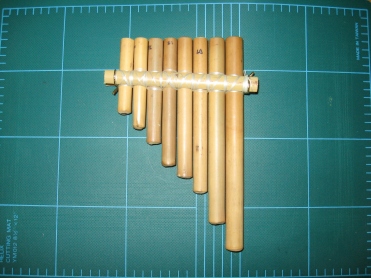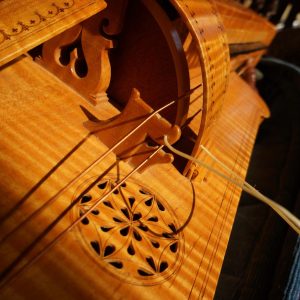 As of this writing, there is no good source of practical information available regarding the construction of pan pipes, so I did a couple of tests to establish some general principles for pan-pipe scaling. The question I was trying to answer was:
As of this writing, there is no good source of practical information available regarding the construction of pan pipes, so I did a couple of tests to establish some general principles for pan-pipe scaling. The question I was trying to answer was:
Given a pitch, what is the ideal internal length and diameter of the pipe?
Since cane is a natural material, it will not conform to the precise dimensions defined here, however these numbers should provide a reasonable starting point for experimentation.
Length
Acousticians say that the sounding length of a stopped tube (such as a panpipe pipe) is 1/4 the wavelength of the sound produced. In actual practice, the open end of the pipe “loads” the resonating chamber, and the formula I have come up with, (based on simple tests using Lucite tubes of various lengths) is this:
Sounding length = 2.4123*Wavelength
The wavelength of a pitch can be determined as follows:
Wavelength = speed of sound / frequency
Given a sea level speed of sound of 345 meters per second, this produces the values shown in the following graph. The red line is an idealized curve of all notes between F#3 (261.63) and A#6 (1864.66). The dark blue indicates values physically determined from cut Lucite tubes, and the green line are the intervals from Henry Thomas’s Bull Doze Blues, which is a early blues recording featuring the rare American panpipe, the Quills – which is what got me thinking about this in the first place.
The following is the table used to calculate the values for the idealized curve shown in the graph above.
| Note | Frequency (Hz) | Calculated wave length (mm) | Pipe length (mm) | Pipe width (mm) |
| F#3/Gb3 | 185 | 1864.9 | 449.87 | 40.90 |
| G3 | 196 | 1760.2 | 424.62 | 38.60 |
| G#3/Ab3 | 207.65 | 1661.4 | 400.80 | 36.44 |
| A3 | 220 | 1568.2 | 378.30 | 34.39 |
| A#3/Bb3 | 233.08 | 1480.2 | 357.07 | 32.46 |
| B3 | 246.94 | 1397.1 | 337.03 | 30.64 |
| C4 | 261.63 | 1318.7 | 318.11 | 28.92 |
| C#4/Db4 | 277.18 | 1244.7 | 300.26 | 27.30 |
| D4 | 293.66 | 1174.8 | 283.41 | 25.76 |
| D#4/Eb4 | 311.13 | 1108.9 | 267.50 | 24.32 |
| E4 | 329.63 | 1046.6 | 252.48 | 22.95 |
| F4 | 349.23 | 987.9 | 238.31 | 21.66 |
| F#4/Gb4 | 369.99 | 932.5 | 224.94 | 20.45 |
| G4 | 392 | 880.1 | 212.31 | 19.30 |
| G#4/Ab4 | 415.3 | 830.7 | 200.40 | 18.22 |
| A4 | 440 | 784.1 | 189.15 | 17.20 |
| A#4/Bb4 | 466.16 | 740.1 | 178.54 | 16.23 |
| B4 | 493.88 | 698.6 | 168.51 | 15.32 |
| C5 | 523.25 | 659.3 | 159.06 | 14.46 |
| C#5/Db5 | 554.37 | 622.3 | 150.13 | 13.65 |
| D5 | 587.33 | 587.4 | 141.70 | 12.88 |
| D#5/Eb5 | 622.25 | 554.4 | 133.75 | 12.16 |
| E5 | 659.26 | 523.3 | 126.24 | 11.48 |
| F5 | 698.46 | 493.9 | 119.16 | 10.83 |
| F#5/Gb5 | 739.99 | 466.2 | 112.47 | 10.22 |
| G5 | 783.99 | 440.1 | 106.16 | 9.65 |
| G#5/Ab5 | 830.61 | 415.4 | 100.20 | 9.11 |
| A5 | 880 | 392.0 | 94.58 | 8.60 |
| A#5/Bb5 | 932.33 | 370.0 | 89.27 | 8.12 |
| B5 | 987.77 | 349.3 | 84.26 | 7.66 |
| C6 | 1046.5 | 329.7 | 79.53 | 7.23 |
| C#6/Db6 | 1108.73 | 311.2 | 75.06 | 6.82 |
| D6 | 1174.66 | 293.7 | 70.85 | 6.44 |
| D#6/Eb6 | 1244.51 | 277.2 | 66.87 | 6.08 |
| E6 | 1318.51 | 261.7 | 63.12 | 5.74 |
| F6 | 1396.91 | 247.0 | 59.58 | 5.42 |
| F#6/Gb6 | 1479.98 | 233.1 | 56.23 | 5.11 |
| G6 | 1567.98 | 220.0 | 53.08 | 4.83 |
| G#6/Ab6 | 1661.22 | 207.7 | 50.10 | 4.55 |
| A6 | 1760 | 196.0 | 47.29 | 4.30 |
| A#6/Bb6 | 1864.66 | 185.0 | 44.63 | 4.06 |
Diameter
I’ve found that a ratio of between 10 to 1 and 15 to 1 for length to bore works well. I have been using 11 or 12 to 1 in my experiments, and 11 to 1 is used in the example above. Good sounding pipes can diverge from this value and still sound well, which is a good thing because bamboo or cane is rarely exactly the size you need.
More information on panpipes and the quills can be found in the following posts:
